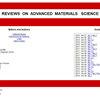利用当代人工智能方法研究碱活性混凝土的流变特性
IF 3.6
4区 材料科学
Q2 MATERIALS SCIENCE, MULTIDISCIPLINARY
引用次数: 0
摘要
本研究利用基于人工智能的工具,旨在建立碱活性混凝土(AAC)混合料设计因素与其性能之间的直接相关性。更具体地说,机器学习系统从实验室实验中使用的 AAC 混合料中获得了新的属性数据。使用多层感知器神经网络(MLPNN)和袋装集合(BE)模型预测了 AAC 的流变参数(屈服应力[静态/动态]和塑性粘度)。此外,还采用了 R 2 值、k 倍分析、统计校验以及实验和预测抗压强度之间的差异来评估所创建模型的性能。此外,还使用了 SHapley 加法规划(SHAP)方法来检查影响参数的相关性。结果发现,BE 方法在所有预测模型中都非常精确,R 2 大于 0.90,而 MLPNN 模型的精确度适中,R 2 略低于 0.90。然而,通过统计检查和 k-fold 分析进行的误差评估也验证了 BE 模型的精度高于 MLPNN 模型。与在实验室进行测试相比,建立可计算不同输入参数值下 AAC 流变特性的模型可节省大量时间和金钱。为了确定所需的 AAC 原材料数量,研究人员和企业可能会发现 SHAP 研究很有帮助。本文章由计算机程序翻译,如有差异,请以英文原文为准。
Investigating the rheological characteristics of alkali-activated concrete using contemporary artificial intelligence approaches
Using artificial intelligence-based tools, this research aims to establish a direct correlation between the alkali-activated concrete (AAC) mix design factors and their performances. More specifically, the machine learning system was fed new property data obtained from AAC mixes used in laboratory experiments. The rheological parameters (yield stress [static/dynamic] and plastic viscosity) of AAC were predicted using the multilayer perceptron neural network (MLPNN) and bagging ensemble (BE) models. In addition, the R 2 values, k-fold analyses, statistical checks, and the dissimilarity between the experimental and predicted compressive strength were employed to assess the performance of the created models. Also, the SHapley additive exPlanation (SHAP) approach was used for examining the relevance of influencing parameters. The BE approach was found to be significantly accurate in all prediction models, with R 2 greater than 0.90, and MLPNN models were found to be moderately precise, with R 2 slightly below 0.90. However, the error assessment through statistical checks and k-fold analysis also validated the higher precision of BE models over the MLPNN models. Building models that can calculate rheological properties of AAC for different values of input parameters could save a lot of time and money compared to doing the tests in a laboratory. In order to ascertain the required amounts of raw materials of AAC, investigators, as well as businesses, may find the SHAP study helpful.
求助全文
通过发布文献求助,成功后即可免费获取论文全文。
去求助
来源期刊

Reviews on Advanced Materials Science
工程技术-材料科学:综合
CiteScore
5.10
自引率
11.10%
发文量
43
审稿时长
3.5 months
期刊介绍:
Reviews on Advanced Materials Science is a fully peer-reviewed, open access, electronic journal that publishes significant, original and relevant works in the area of theoretical and experimental studies of advanced materials. The journal provides the readers with free, instant, and permanent access to all content worldwide; and the authors with extensive promotion of published articles, long-time preservation, language-correction services, no space constraints and immediate publication.
Reviews on Advanced Materials Science is listed inter alia by Clarivate Analytics (formerly Thomson Reuters) - Current Contents/Physical, Chemical, and Earth Sciences (CC/PC&ES), JCR and SCIE. Our standard policy requires each paper to be reviewed by at least two Referees and the peer-review process is single-blind.
 求助内容:
求助内容: 应助结果提醒方式:
应助结果提醒方式:


